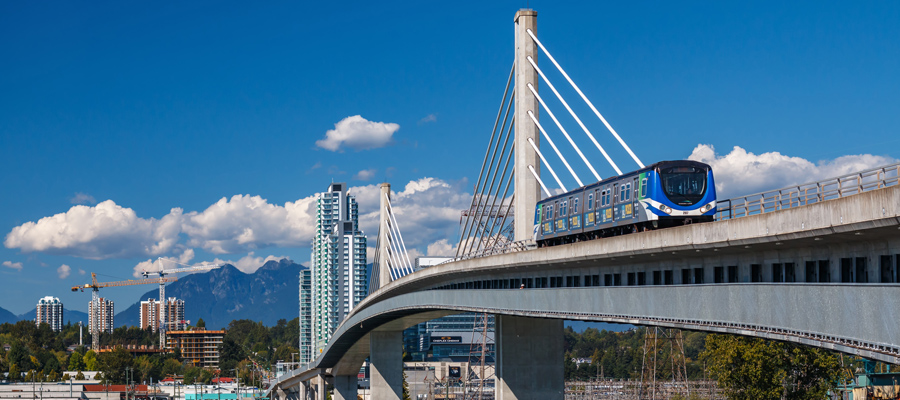Big transportation investments needed now in Metro Vancouver: Budget 2018

In Metro Vancouver, as the region’s population has grown so has its congestion problems.
Whether enduring a long wait to cross a bridge or get on a bus, everyone can relate to the additional time and stress caused by a transportation system under strain. Metro Vancouver is, for all intents and purposes, at “peak car”: the mobility of a growing regional population cannot be accommodated with more private cars. A 2015 study put the costs of congestion in Metro Vancouver at between $500 million and $1.2 billion per year.
It is widely agreed that major new investments are needed for Vancouver’s public transit system to alleviate crowded conditions for transit users and congestion for drivers. Special arrangements—like priority lanes and increased services—during the 2010 Winter Olympics provided a taste of what an expanded transit system could look like. Public investment in convenient, high-quality transit can reduce costs for many households, improve air quality, boost public health and help reduce greenhouse gas pollution that causes climate change.
Stable, long-term funding for public transit is the missing ingredient.
Special arrangements—like priority lanes and increased services—during the 2010 Winter Olympics provided a taste of what an expanded transit system could look like.
The 2015 Mayors’ Council on Regional Transportation Ten-Year Plan calls for $7.5 billion capital investment to keep up with population growth and build and upgrade infrastructure. This includes building a new Pattullo bridge, adding substantial new transit capacity, including a new Broadway extension of the Millennium Skytrain line and two new light rail lines in Surrey, among other upgrades.
Federal and provincial contributions are anticipated to cover a large share of the upfront capital costs of the Mayors’ Plan, but TransLink must pay its share of the capital costs as well as the operating costs of new infrastructure and services. A bid for a half-percentage point regional sales tax failed in a BC-government-imposed referendum in 2015.
Nonetheless, this year Translink launched Phase 1 of the Ten-Year Plan, including a number of service upgrades such as new Skytrain cars and buses. TransLink was able to move on Phase 1 because it sold its former bus depot near Oakridge Mall, a one-time $440 million infusion. TransLink has also proposed a regional development cost charge that would raise $15-20 million per year, which should be supported by the BC government.
TransLink’s share of funding for the bigger-ticket Phases 2 and 3, which include the Broadway subway and two lines of light rail in Surrey, is still uncertain. In the medium term, TransLink is looking to a regional share of incremental revenues from scheduled increases in BC’s carbon tax, which is set to rise $5 per tonne (about 1.2 cents per litre at the gas pump) in April 2018 and for the subsequent three years.
Further to this, TransLink is exploring “mobility pricing” alternatives to support transportation system upgrades over the long term. What such a system would look like and cost is still under study. But, related was the new BC government’s decision to end tolls on TransLink’s Golden Ears bridge and the BC government-run Port Mann bridge as of September 2017.
TransLink is exploring “mobility pricing” alternatives to support transportation system upgrades over the long term.
The provincial decision to end tolling on two new bridges is anticipated to cost $479 million over three years, according to the government’s September budget update. While the Province is responsible for Port Mann bridge, funding from the BC government to TransLink to replace toll revenue from the Golden Ears bridge needs to be clarified in the February budget. The region must replace $52 million (in 2016) in Golden Ears tolling revenue.
As TransLink and the BC government talk about how best to finance transportation, care should be taken to ensure that the overall mix of taxes and user fees is progressive. For example, transit fares went up modestly in June 2017, but are set to rise annually, meaning a one-zone fare in 2026 will be $3.55 up from $2.75 in 2016. As a general principle, TransLink should keep a lid on fare increases, and ensure that over time the relative cost of transit falls compared to car options to reduce congestion and air pollution.
A better way to raise needed revenues is a shift to progressive property taxation rather than across-the-board property tax increases. In our housing research we have modeled a progressive property surtax in support of building affordable housing, but a similar tax framework could be applied to supporting regional transportation (although it would require legislative change by the BC government). A shift to progressive property taxation would also allow lower transit fares, leading to higher ridership and less burden on low-income households.
In addition, TransLink should be encouraged to use its existing authority to establish an area benefitting tax in proximity to transit stations. Called “land value capture”, such a move is recommended to capture some of the increase in property values arising from public transit investments and this income can then fund public services and infrastructure investments.
A shift to progressive property taxation would also allow lower transit fares, leading to higher ridership and less burden on low-income households.
The previous BC government focused too much attention on new bridge mega-projects instead of regional transportation needs. The new BC government’s cancellation of the proposed $3-billion Massey bridge project is a sensible move, especially in light of opposition to the proposed bridge by all of the region’s mayors (except for Delta).
This $3 billion in capital funding should be reallocated to fully support the costs of a new Pattullo bridge—a top regional priority—and the BC government should increase its share of capital costs for the Mayors’ plan. For example, the BC government paid all the capital costs for the Millennium line.
An efficient and effective transportation system is central to a city’s social and economic health. While Metro Vancouver has embraced a vision of shifting from cars to transit, biking and walking, financing those investments is an ongoing challenge. Budget 2018 should get the ball rolling for a generation of major public transit investments to improve the region’s livability.
Topics: Climate change & energy policy, Economy, Environment, resources & sustainability, Provincial budget & finance, Taxes


